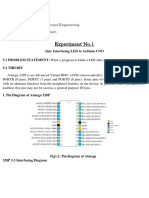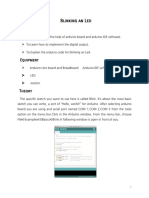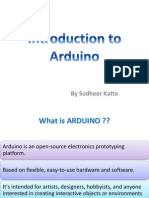Programming Arduino (1) Pages 144
Uploaded by
axl1994Programming Arduino (1) Pages 144
Uploaded by
axl1994significant bit or the most significant.
This should be one of the constants
MSBFIRST or LSBFIRST .
♦ The byte of data to be sent.
Interrupts
One of the things that tend to frustrate programmers used to “programming in
the large” is that the Arduino can do only one thing at a time. If you like to have
lots of threads of execution all running at the same time in your programs, then
you are out of luck. Although a few people have developed projects that can
execute multiple threads in this way, generally this capability is unnecessary for
the type of uses that an Arduino is normally put to. The closest an Arduino
usually gets to such execution is the use of interrupts.
Two of the pins on the Arduino Uno (D2 and D3) can have interrupts
attached to them. That is, these pins act as inputs that, if the pins receive a signal
in a specified way, the Arduino’s processor will suspend whatever it was doing
and run a function attached to that interrupt.
Sketch 7-04 blinks an LED, but then changes the blink period when an
interrupt is received. You can simulate an interrupt by connecting your wire
between pin D2 and GND and using the internal pull-up resistor to keep the
interrupt high most of the time.
//sketch 7-04
const int interruptPin = 2;
const int ledPin = 13;
int period = 500;
void setup()
You might also like
- Arduino: The ultimate guide to Arduino, including projects, programming tips & tricks, and much more!From EverandArduino: The ultimate guide to Arduino, including projects, programming tips & tricks, and much more!No ratings yet
- Introduction To Arduino Programming: Jinasena Innovation & Technology Institute - EkalaNo ratings yetIntroduction To Arduino Programming: Jinasena Innovation & Technology Institute - Ekala60 pages
- Electronics & Robotics Club: Introductory Lecture ON ArduinoNo ratings yetElectronics & Robotics Club: Introductory Lecture ON Arduino60 pages
- Using Interrupts On Arduino - Technical ArticlesNo ratings yetUsing Interrupts On Arduino - Technical Articles2 pages
- Arduino: The Ultimate Guide to Arduino for Beginners Including Arduino Basics, Tips & Tricks, Projects, and More!From EverandArduino: The Ultimate Guide to Arduino for Beginners Including Arduino Basics, Tips & Tricks, Projects, and More!No ratings yet
- Exercises 4 - Hardware Timers and InterruptsNo ratings yetExercises 4 - Hardware Timers and Interrupts8 pages
- How To Set Up Your Arduino To Blink An LED With A Switch Key PointsNo ratings yetHow To Set Up Your Arduino To Blink An LED With A Switch Key Points5 pages
- Arduino Interrupts Speed up your Arduino to be responsive to events 1st Edition Kühnel 2024 Scribd Download100% (1)Arduino Interrupts Speed up your Arduino to be responsive to events 1st Edition Kühnel 2024 Scribd Download67 pages
- Arduino Interrupts Tutorial - The Robotics Back-EndNo ratings yetArduino Interrupts Tutorial - The Robotics Back-End19 pages
- American International University of BangladeshNo ratings yetAmerican International University of Bangladesh9 pages
- Arduino Interrupts Speed up your Arduino to be responsive to events 1st Edition Kühnel - Download the ebook now and read anytime, anywhere100% (1)Arduino Interrupts Speed up your Arduino to be responsive to events 1st Edition Kühnel - Download the ebook now and read anytime, anywhere57 pages
- Arduino For Beginners: How to get the most of out of your Arduino, including Arduino basics, Arduino tips and tricks, Arduino projects and more!From EverandArduino For Beginners: How to get the most of out of your Arduino, including Arduino basics, Arduino tips and tricks, Arduino projects and more!No ratings yet

































































